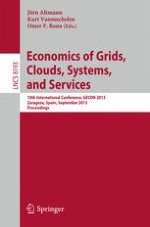2013 | Buch
Economics of Grids, Clouds, Systems, and Services
10th International Conference, GECON 2013, Zaragoza, Spain, September 18-20, 2013. Proceedings
herausgegeben von: Jörn Altmann, Kurt Vanmechelen, Omer F. Rana
Verlag: Springer International Publishing
Buchreihe : Lecture Notes in Computer Science
